Analysis of Theories Underpinning Residential Childcare: CareTech
VerifiedAdded on 2022/12/27
|13
|4222
|70
Essay
AI Summary
This essay provides a comprehensive overview of the theories underpinning residential childcare, focusing on child development, group dynamics, and attachment. It begins by summarizing key child development theories, including psychoanalytic and humanist perspectives, highlighting their application within CareTech. The essay then explores theories related to group living, such as social pedagogy and group care theories, emphasizing their role in fostering positive social interactions and therapeutic environments. Furthermore, it examines the impact of the physical environment on children in group settings, including homeliness and functionality theories. The social pedagogy framework is discussed, illustrating its holistic approach to child well-being, growth, and learning. Finally, the essay delves into attachment theories, specifically Bowlby's and Dollard & Miller's theories, and their significance in understanding and supporting the emotional bonds of children in residential care, with examples of how these theories are applied in practice.
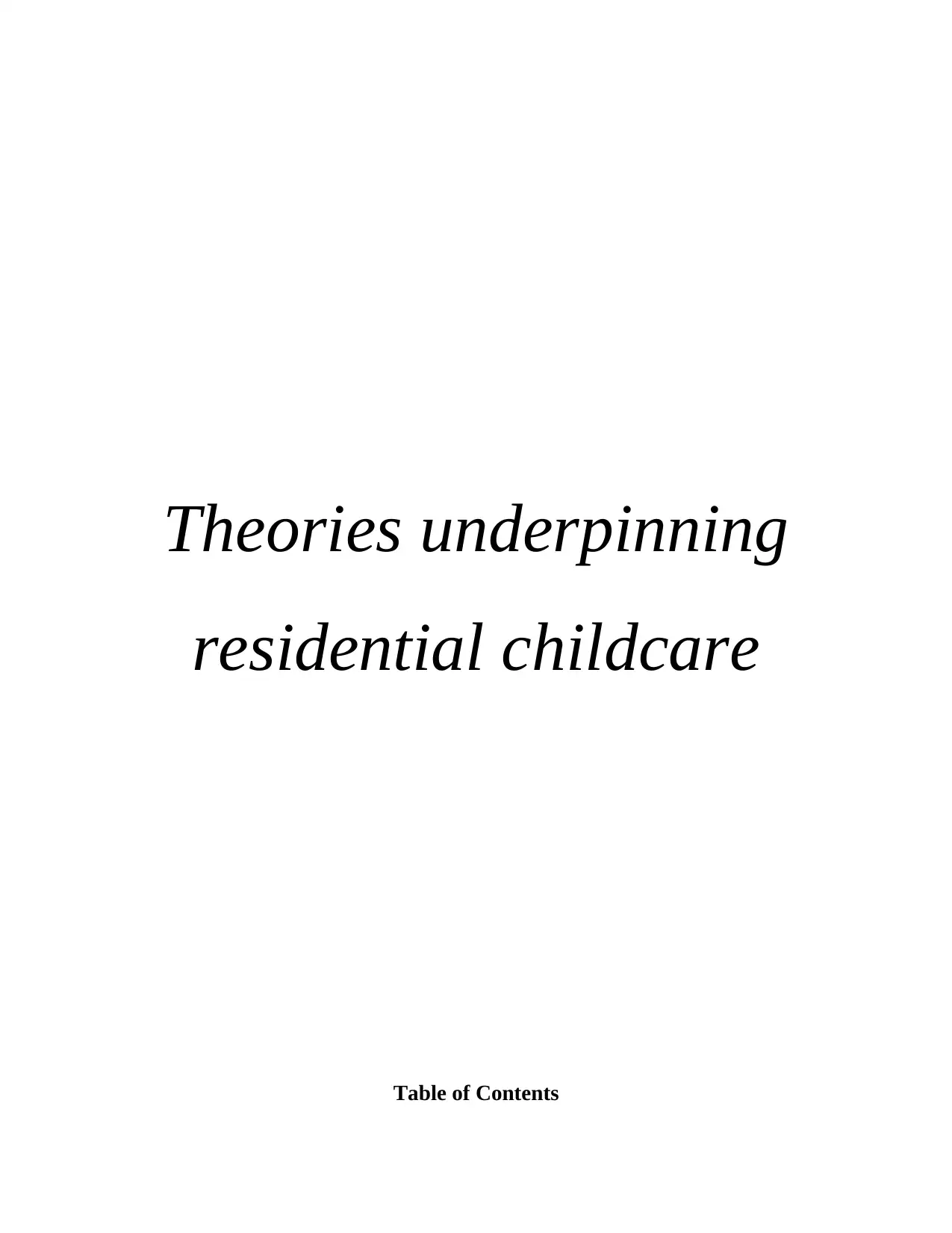
Theories underpinning
residential childcare
Table of Contents
residential childcare
Table of Contents
Paraphrase This Document
Need a fresh take? Get an instant paraphrase of this document with our AI Paraphraser
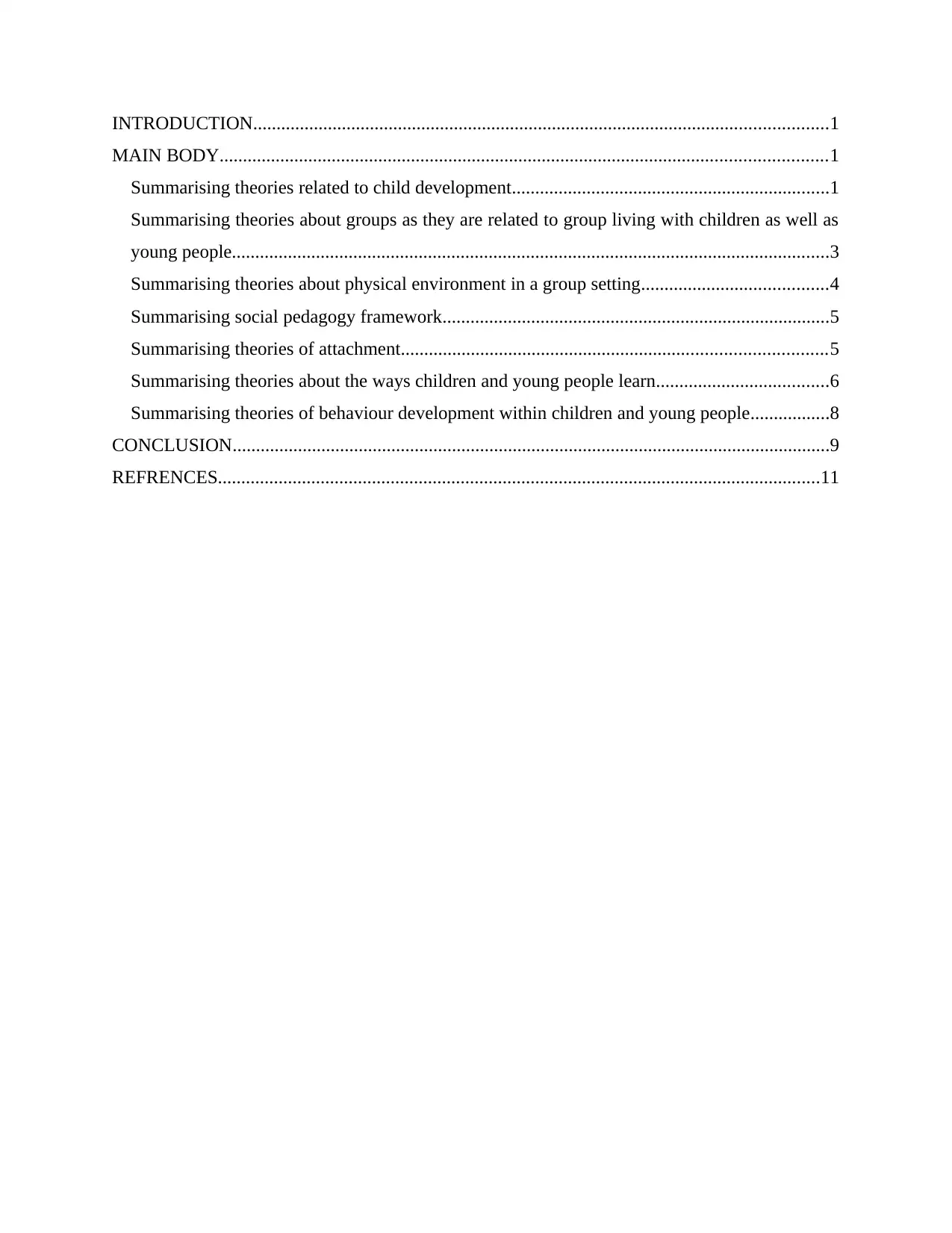
INTRODUCTION...........................................................................................................................1
MAIN BODY..................................................................................................................................1
Summarising theories related to child development....................................................................1
Summarising theories about groups as they are related to group living with children as well as
young people................................................................................................................................3
Summarising theories about physical environment in a group setting........................................4
Summarising social pedagogy framework...................................................................................5
Summarising theories of attachment...........................................................................................5
Summarising theories about the ways children and young people learn.....................................6
Summarising theories of behaviour development within children and young people.................8
CONCLUSION................................................................................................................................9
REFRENCES.................................................................................................................................11
MAIN BODY..................................................................................................................................1
Summarising theories related to child development....................................................................1
Summarising theories about groups as they are related to group living with children as well as
young people................................................................................................................................3
Summarising theories about physical environment in a group setting........................................4
Summarising social pedagogy framework...................................................................................5
Summarising theories of attachment...........................................................................................5
Summarising theories about the ways children and young people learn.....................................6
Summarising theories of behaviour development within children and young people.................8
CONCLUSION................................................................................................................................9
REFRENCES.................................................................................................................................11
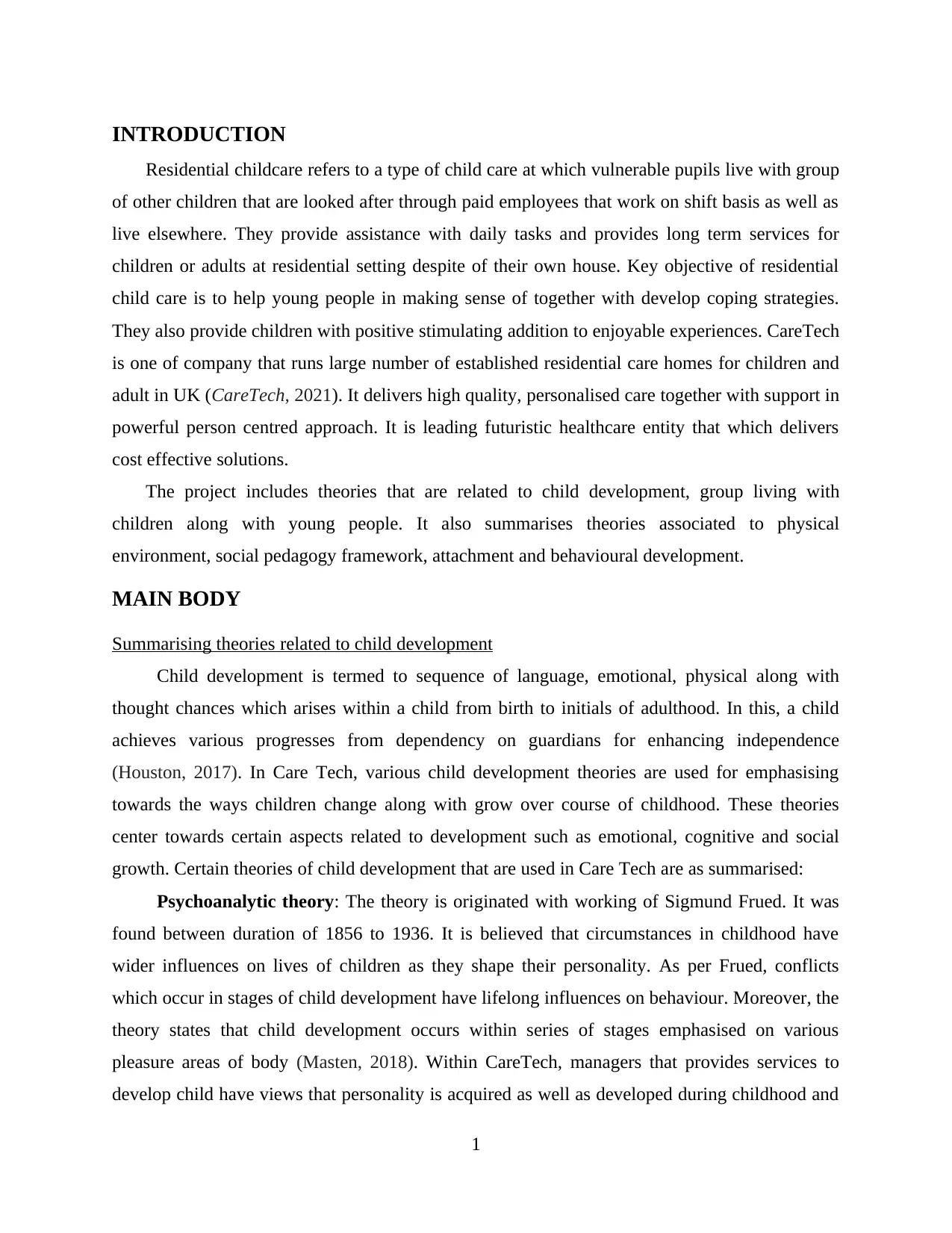
INTRODUCTION
Residential childcare refers to a type of child care at which vulnerable pupils live with group
of other children that are looked after through paid employees that work on shift basis as well as
live elsewhere. They provide assistance with daily tasks and provides long term services for
children or adults at residential setting despite of their own house. Key objective of residential
child care is to help young people in making sense of together with develop coping strategies.
They also provide children with positive stimulating addition to enjoyable experiences. CareTech
is one of company that runs large number of established residential care homes for children and
adult in UK (CareTech, 2021). It delivers high quality, personalised care together with support in
powerful person centred approach. It is leading futuristic healthcare entity that which delivers
cost effective solutions.
The project includes theories that are related to child development, group living with
children along with young people. It also summarises theories associated to physical
environment, social pedagogy framework, attachment and behavioural development.
MAIN BODY
Summarising theories related to child development
Child development is termed to sequence of language, emotional, physical along with
thought chances which arises within a child from birth to initials of adulthood. In this, a child
achieves various progresses from dependency on guardians for enhancing independence
(Houston, 2017). In Care Tech, various child development theories are used for emphasising
towards the ways children change along with grow over course of childhood. These theories
center towards certain aspects related to development such as emotional, cognitive and social
growth. Certain theories of child development that are used in Care Tech are as summarised:
Psychoanalytic theory: The theory is originated with working of Sigmund Frued. It was
found between duration of 1856 to 1936. It is believed that circumstances in childhood have
wider influences on lives of children as they shape their personality. As per Frued, conflicts
which occur in stages of child development have lifelong influences on behaviour. Moreover, the
theory states that child development occurs within series of stages emphasised on various
pleasure areas of body (Masten, 2018). Within CareTech, managers that provides services to
develop child have views that personality is acquired as well as developed during childhood and
1
Residential childcare refers to a type of child care at which vulnerable pupils live with group
of other children that are looked after through paid employees that work on shift basis as well as
live elsewhere. They provide assistance with daily tasks and provides long term services for
children or adults at residential setting despite of their own house. Key objective of residential
child care is to help young people in making sense of together with develop coping strategies.
They also provide children with positive stimulating addition to enjoyable experiences. CareTech
is one of company that runs large number of established residential care homes for children and
adult in UK (CareTech, 2021). It delivers high quality, personalised care together with support in
powerful person centred approach. It is leading futuristic healthcare entity that which delivers
cost effective solutions.
The project includes theories that are related to child development, group living with
children along with young people. It also summarises theories associated to physical
environment, social pedagogy framework, attachment and behavioural development.
MAIN BODY
Summarising theories related to child development
Child development is termed to sequence of language, emotional, physical along with
thought chances which arises within a child from birth to initials of adulthood. In this, a child
achieves various progresses from dependency on guardians for enhancing independence
(Houston, 2017). In Care Tech, various child development theories are used for emphasising
towards the ways children change along with grow over course of childhood. These theories
center towards certain aspects related to development such as emotional, cognitive and social
growth. Certain theories of child development that are used in Care Tech are as summarised:
Psychoanalytic theory: The theory is originated with working of Sigmund Frued. It was
found between duration of 1856 to 1936. It is believed that circumstances in childhood have
wider influences on lives of children as they shape their personality. As per Frued, conflicts
which occur in stages of child development have lifelong influences on behaviour. Moreover, the
theory states that child development occurs within series of stages emphasised on various
pleasure areas of body (Masten, 2018). Within CareTech, managers that provides services to
develop child have views that personality is acquired as well as developed during childhood and
1
⊘ This is a preview!⊘
Do you want full access?
Subscribe today to unlock all pages.

Trusted by 1+ million students worldwide
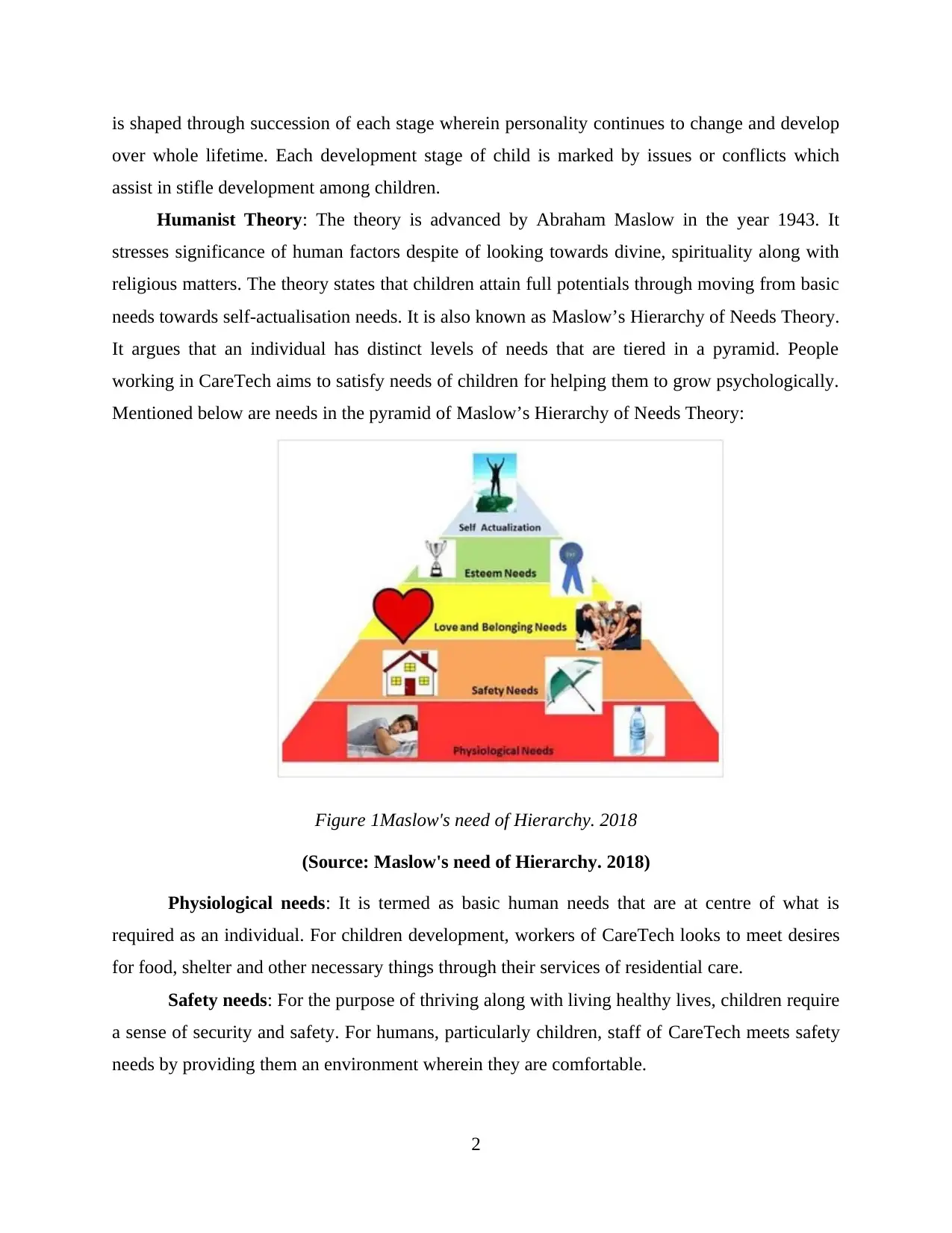
is shaped through succession of each stage wherein personality continues to change and develop
over whole lifetime. Each development stage of child is marked by issues or conflicts which
assist in stifle development among children.
Humanist Theory: The theory is advanced by Abraham Maslow in the year 1943. It
stresses significance of human factors despite of looking towards divine, spirituality along with
religious matters. The theory states that children attain full potentials through moving from basic
needs towards self-actualisation needs. It is also known as Maslow’s Hierarchy of Needs Theory.
It argues that an individual has distinct levels of needs that are tiered in a pyramid. People
working in CareTech aims to satisfy needs of children for helping them to grow psychologically.
Mentioned below are needs in the pyramid of Maslow’s Hierarchy of Needs Theory:
Figure 1Maslow's need of Hierarchy. 2018
(Source: Maslow's need of Hierarchy. 2018)
Physiological needs: It is termed as basic human needs that are at centre of what is
required as an individual. For children development, workers of CareTech looks to meet desires
for food, shelter and other necessary things through their services of residential care.
Safety needs: For the purpose of thriving along with living healthy lives, children require
a sense of security and safety. For humans, particularly children, staff of CareTech meets safety
needs by providing them an environment wherein they are comfortable.
2
over whole lifetime. Each development stage of child is marked by issues or conflicts which
assist in stifle development among children.
Humanist Theory: The theory is advanced by Abraham Maslow in the year 1943. It
stresses significance of human factors despite of looking towards divine, spirituality along with
religious matters. The theory states that children attain full potentials through moving from basic
needs towards self-actualisation needs. It is also known as Maslow’s Hierarchy of Needs Theory.
It argues that an individual has distinct levels of needs that are tiered in a pyramid. People
working in CareTech aims to satisfy needs of children for helping them to grow psychologically.
Mentioned below are needs in the pyramid of Maslow’s Hierarchy of Needs Theory:
Figure 1Maslow's need of Hierarchy. 2018
(Source: Maslow's need of Hierarchy. 2018)
Physiological needs: It is termed as basic human needs that are at centre of what is
required as an individual. For children development, workers of CareTech looks to meet desires
for food, shelter and other necessary things through their services of residential care.
Safety needs: For the purpose of thriving along with living healthy lives, children require
a sense of security and safety. For humans, particularly children, staff of CareTech meets safety
needs by providing them an environment wherein they are comfortable.
2
Paraphrase This Document
Need a fresh take? Get an instant paraphrase of this document with our AI Paraphraser
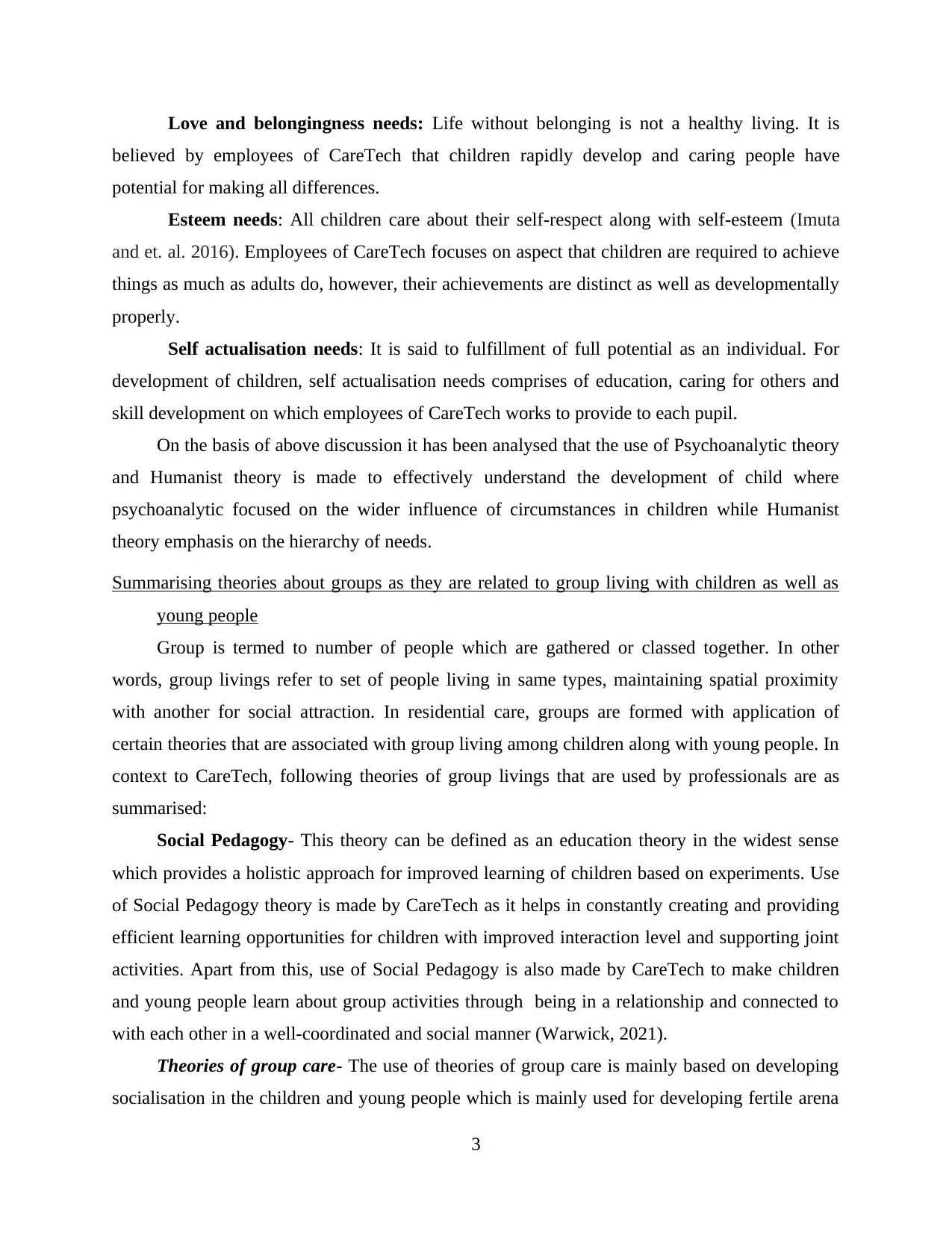
Love and belongingness needs: Life without belonging is not a healthy living. It is
believed by employees of CareTech that children rapidly develop and caring people have
potential for making all differences.
Esteem needs: All children care about their self-respect along with self-esteem (Imuta
and et. al. 2016). Employees of CareTech focuses on aspect that children are required to achieve
things as much as adults do, however, their achievements are distinct as well as developmentally
properly.
Self actualisation needs: It is said to fulfillment of full potential as an individual. For
development of children, self actualisation needs comprises of education, caring for others and
skill development on which employees of CareTech works to provide to each pupil.
On the basis of above discussion it has been analysed that the use of Psychoanalytic theory
and Humanist theory is made to effectively understand the development of child where
psychoanalytic focused on the wider influence of circumstances in children while Humanist
theory emphasis on the hierarchy of needs.
Summarising theories about groups as they are related to group living with children as well as
young people
Group is termed to number of people which are gathered or classed together. In other
words, group livings refer to set of people living in same types, maintaining spatial proximity
with another for social attraction. In residential care, groups are formed with application of
certain theories that are associated with group living among children along with young people. In
context to CareTech, following theories of group livings that are used by professionals are as
summarised:
Social Pedagogy- This theory can be defined as an education theory in the widest sense
which provides a holistic approach for improved learning of children based on experiments. Use
of Social Pedagogy theory is made by CareTech as it helps in constantly creating and providing
efficient learning opportunities for children with improved interaction level and supporting joint
activities. Apart from this, use of Social Pedagogy is also made by CareTech to make children
and young people learn about group activities through being in a relationship and connected to
with each other in a well-coordinated and social manner (Warwick, 2021).
Theories of group care- The use of theories of group care is mainly based on developing
socialisation in the children and young people which is mainly used for developing fertile arena
3
believed by employees of CareTech that children rapidly develop and caring people have
potential for making all differences.
Esteem needs: All children care about their self-respect along with self-esteem (Imuta
and et. al. 2016). Employees of CareTech focuses on aspect that children are required to achieve
things as much as adults do, however, their achievements are distinct as well as developmentally
properly.
Self actualisation needs: It is said to fulfillment of full potential as an individual. For
development of children, self actualisation needs comprises of education, caring for others and
skill development on which employees of CareTech works to provide to each pupil.
On the basis of above discussion it has been analysed that the use of Psychoanalytic theory
and Humanist theory is made to effectively understand the development of child where
psychoanalytic focused on the wider influence of circumstances in children while Humanist
theory emphasis on the hierarchy of needs.
Summarising theories about groups as they are related to group living with children as well as
young people
Group is termed to number of people which are gathered or classed together. In other
words, group livings refer to set of people living in same types, maintaining spatial proximity
with another for social attraction. In residential care, groups are formed with application of
certain theories that are associated with group living among children along with young people. In
context to CareTech, following theories of group livings that are used by professionals are as
summarised:
Social Pedagogy- This theory can be defined as an education theory in the widest sense
which provides a holistic approach for improved learning of children based on experiments. Use
of Social Pedagogy theory is made by CareTech as it helps in constantly creating and providing
efficient learning opportunities for children with improved interaction level and supporting joint
activities. Apart from this, use of Social Pedagogy is also made by CareTech to make children
and young people learn about group activities through being in a relationship and connected to
with each other in a well-coordinated and social manner (Warwick, 2021).
Theories of group care- The use of theories of group care is mainly based on developing
socialisation in the children and young people which is mainly used for developing fertile arena
3
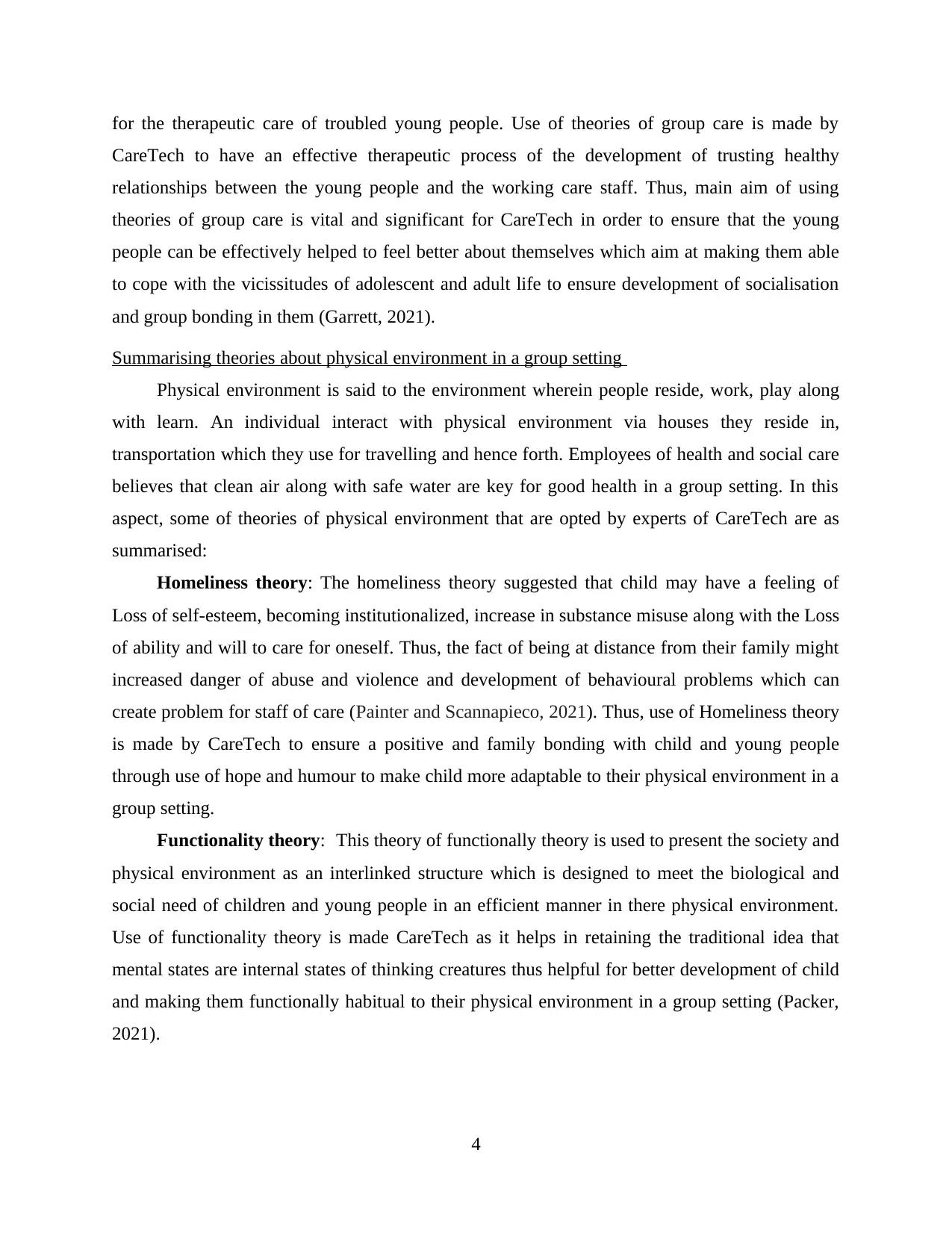
for the therapeutic care of troubled young people. Use of theories of group care is made by
CareTech to have an effective therapeutic process of the development of trusting healthy
relationships between the young people and the working care staff. Thus, main aim of using
theories of group care is vital and significant for CareTech in order to ensure that the young
people can be effectively helped to feel better about themselves which aim at making them able
to cope with the vicissitudes of adolescent and adult life to ensure development of socialisation
and group bonding in them (Garrett, 2021).
Summarising theories about physical environment in a group setting
Physical environment is said to the environment wherein people reside, work, play along
with learn. An individual interact with physical environment via houses they reside in,
transportation which they use for travelling and hence forth. Employees of health and social care
believes that clean air along with safe water are key for good health in a group setting. In this
aspect, some of theories of physical environment that are opted by experts of CareTech are as
summarised:
Homeliness theory: The homeliness theory suggested that child may have a feeling of
Loss of self-esteem, becoming institutionalized, increase in substance misuse along with the Loss
of ability and will to care for oneself. Thus, the fact of being at distance from their family might
increased danger of abuse and violence and development of behavioural problems which can
create problem for staff of care (Painter and Scannapieco, 2021). Thus, use of Homeliness theory
is made by CareTech to ensure a positive and family bonding with child and young people
through use of hope and humour to make child more adaptable to their physical environment in a
group setting.
Functionality theory: This theory of functionally theory is used to present the society and
physical environment as an interlinked structure which is designed to meet the biological and
social need of children and young people in an efficient manner in there physical environment.
Use of functionality theory is made CareTech as it helps in retaining the traditional idea that
mental states are internal states of thinking creatures thus helpful for better development of child
and making them functionally habitual to their physical environment in a group setting (Packer,
2021).
4
CareTech to have an effective therapeutic process of the development of trusting healthy
relationships between the young people and the working care staff. Thus, main aim of using
theories of group care is vital and significant for CareTech in order to ensure that the young
people can be effectively helped to feel better about themselves which aim at making them able
to cope with the vicissitudes of adolescent and adult life to ensure development of socialisation
and group bonding in them (Garrett, 2021).
Summarising theories about physical environment in a group setting
Physical environment is said to the environment wherein people reside, work, play along
with learn. An individual interact with physical environment via houses they reside in,
transportation which they use for travelling and hence forth. Employees of health and social care
believes that clean air along with safe water are key for good health in a group setting. In this
aspect, some of theories of physical environment that are opted by experts of CareTech are as
summarised:
Homeliness theory: The homeliness theory suggested that child may have a feeling of
Loss of self-esteem, becoming institutionalized, increase in substance misuse along with the Loss
of ability and will to care for oneself. Thus, the fact of being at distance from their family might
increased danger of abuse and violence and development of behavioural problems which can
create problem for staff of care (Painter and Scannapieco, 2021). Thus, use of Homeliness theory
is made by CareTech to ensure a positive and family bonding with child and young people
through use of hope and humour to make child more adaptable to their physical environment in a
group setting.
Functionality theory: This theory of functionally theory is used to present the society and
physical environment as an interlinked structure which is designed to meet the biological and
social need of children and young people in an efficient manner in there physical environment.
Use of functionality theory is made CareTech as it helps in retaining the traditional idea that
mental states are internal states of thinking creatures thus helpful for better development of child
and making them functionally habitual to their physical environment in a group setting (Packer,
2021).
4
⊘ This is a preview!⊘
Do you want full access?
Subscribe today to unlock all pages.

Trusted by 1+ million students worldwide
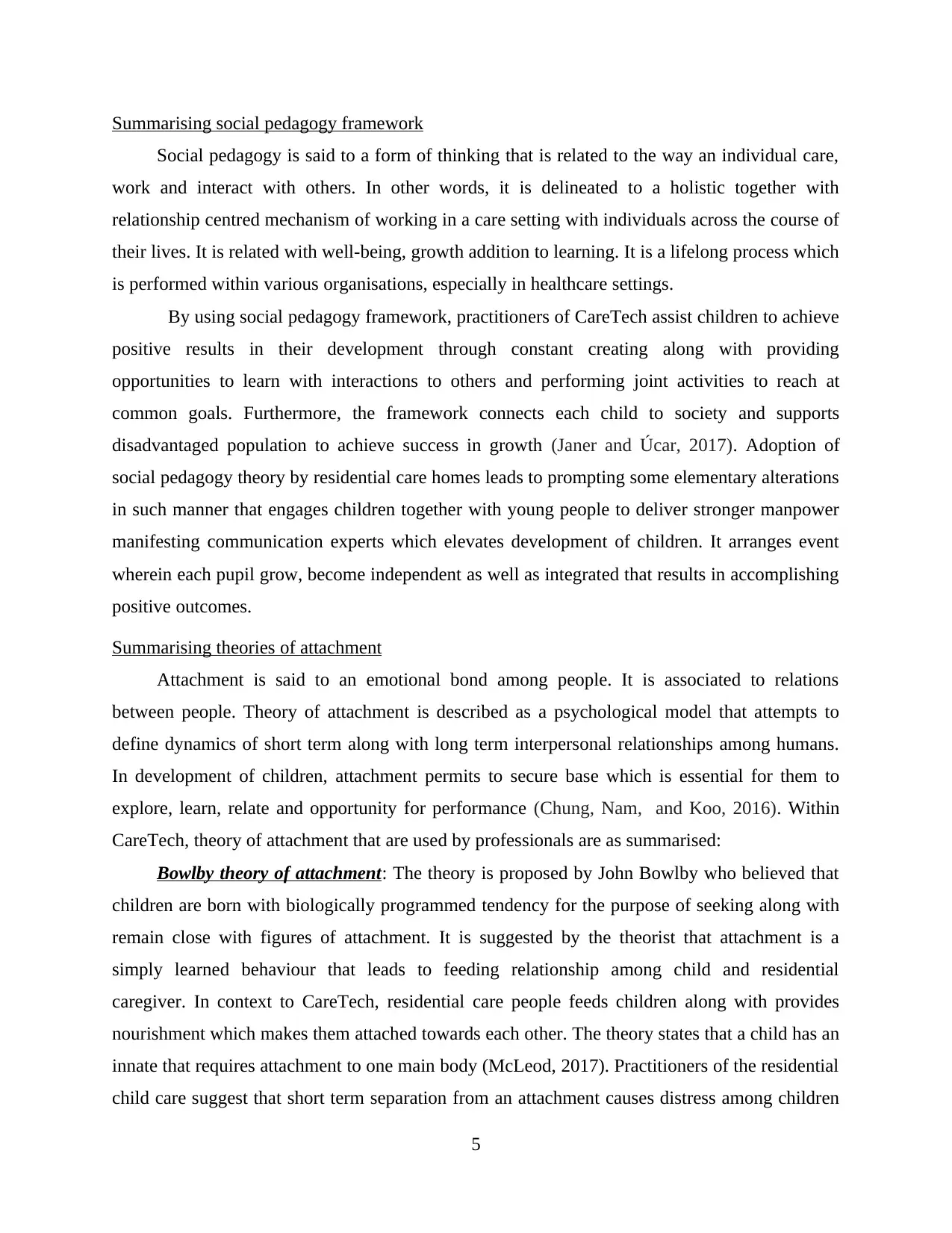
Summarising social pedagogy framework
Social pedagogy is said to a form of thinking that is related to the way an individual care,
work and interact with others. In other words, it is delineated to a holistic together with
relationship centred mechanism of working in a care setting with individuals across the course of
their lives. It is related with well-being, growth addition to learning. It is a lifelong process which
is performed within various organisations, especially in healthcare settings.
By using social pedagogy framework, practitioners of CareTech assist children to achieve
positive results in their development through constant creating along with providing
opportunities to learn with interactions to others and performing joint activities to reach at
common goals. Furthermore, the framework connects each child to society and supports
disadvantaged population to achieve success in growth (Janer and Úcar, 2017). Adoption of
social pedagogy theory by residential care homes leads to prompting some elementary alterations
in such manner that engages children together with young people to deliver stronger manpower
manifesting communication experts which elevates development of children. It arranges event
wherein each pupil grow, become independent as well as integrated that results in accomplishing
positive outcomes.
Summarising theories of attachment
Attachment is said to an emotional bond among people. It is associated to relations
between people. Theory of attachment is described as a psychological model that attempts to
define dynamics of short term along with long term interpersonal relationships among humans.
In development of children, attachment permits to secure base which is essential for them to
explore, learn, relate and opportunity for performance (Chung, Nam, and Koo, 2016). Within
CareTech, theory of attachment that are used by professionals are as summarised:
Bowlby theory of attachment: The theory is proposed by John Bowlby who believed that
children are born with biologically programmed tendency for the purpose of seeking along with
remain close with figures of attachment. It is suggested by the theorist that attachment is a
simply learned behaviour that leads to feeding relationship among child and residential
caregiver. In context to CareTech, residential care people feeds children along with provides
nourishment which makes them attached towards each other. The theory states that a child has an
innate that requires attachment to one main body (McLeod, 2017). Practitioners of the residential
child care suggest that short term separation from an attachment causes distress among children
5
Social pedagogy is said to a form of thinking that is related to the way an individual care,
work and interact with others. In other words, it is delineated to a holistic together with
relationship centred mechanism of working in a care setting with individuals across the course of
their lives. It is related with well-being, growth addition to learning. It is a lifelong process which
is performed within various organisations, especially in healthcare settings.
By using social pedagogy framework, practitioners of CareTech assist children to achieve
positive results in their development through constant creating along with providing
opportunities to learn with interactions to others and performing joint activities to reach at
common goals. Furthermore, the framework connects each child to society and supports
disadvantaged population to achieve success in growth (Janer and Úcar, 2017). Adoption of
social pedagogy theory by residential care homes leads to prompting some elementary alterations
in such manner that engages children together with young people to deliver stronger manpower
manifesting communication experts which elevates development of children. It arranges event
wherein each pupil grow, become independent as well as integrated that results in accomplishing
positive outcomes.
Summarising theories of attachment
Attachment is said to an emotional bond among people. It is associated to relations
between people. Theory of attachment is described as a psychological model that attempts to
define dynamics of short term along with long term interpersonal relationships among humans.
In development of children, attachment permits to secure base which is essential for them to
explore, learn, relate and opportunity for performance (Chung, Nam, and Koo, 2016). Within
CareTech, theory of attachment that are used by professionals are as summarised:
Bowlby theory of attachment: The theory is proposed by John Bowlby who believed that
children are born with biologically programmed tendency for the purpose of seeking along with
remain close with figures of attachment. It is suggested by the theorist that attachment is a
simply learned behaviour that leads to feeding relationship among child and residential
caregiver. In context to CareTech, residential care people feeds children along with provides
nourishment which makes them attached towards each other. The theory states that a child has an
innate that requires attachment to one main body (McLeod, 2017). Practitioners of the residential
child care suggest that short term separation from an attachment causes distress among children
5
Paraphrase This Document
Need a fresh take? Get an instant paraphrase of this document with our AI Paraphraser
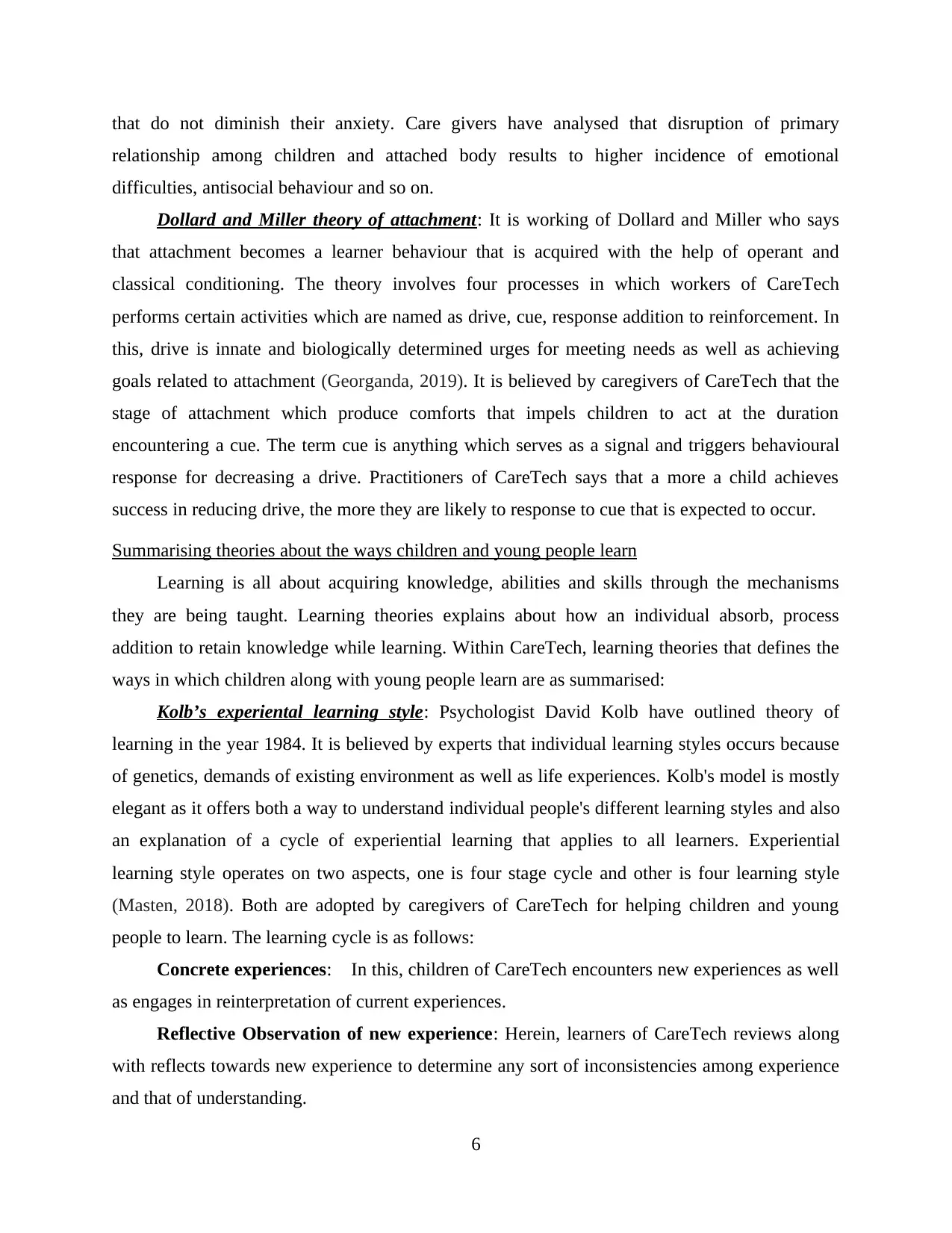
that do not diminish their anxiety. Care givers have analysed that disruption of primary
relationship among children and attached body results to higher incidence of emotional
difficulties, antisocial behaviour and so on.
Dollard and Miller theory of attachment: It is working of Dollard and Miller who says
that attachment becomes a learner behaviour that is acquired with the help of operant and
classical conditioning. The theory involves four processes in which workers of CareTech
performs certain activities which are named as drive, cue, response addition to reinforcement. In
this, drive is innate and biologically determined urges for meeting needs as well as achieving
goals related to attachment (Georganda, 2019). It is believed by caregivers of CareTech that the
stage of attachment which produce comforts that impels children to act at the duration
encountering a cue. The term cue is anything which serves as a signal and triggers behavioural
response for decreasing a drive. Practitioners of CareTech says that a more a child achieves
success in reducing drive, the more they are likely to response to cue that is expected to occur.
Summarising theories about the ways children and young people learn
Learning is all about acquiring knowledge, abilities and skills through the mechanisms
they are being taught. Learning theories explains about how an individual absorb, process
addition to retain knowledge while learning. Within CareTech, learning theories that defines the
ways in which children along with young people learn are as summarised:
Kolb’s experiental learning style: Psychologist David Kolb have outlined theory of
learning in the year 1984. It is believed by experts that individual learning styles occurs because
of genetics, demands of existing environment as well as life experiences. Kolb's model is mostly
elegant as it offers both a way to understand individual people's different learning styles and also
an explanation of a cycle of experiential learning that applies to all learners. Experiential
learning style operates on two aspects, one is four stage cycle and other is four learning style
(Masten, 2018). Both are adopted by caregivers of CareTech for helping children and young
people to learn. The learning cycle is as follows:
Concrete experiences: In this, children of CareTech encounters new experiences as well
as engages in reinterpretation of current experiences.
Reflective Observation of new experience: Herein, learners of CareTech reviews along
with reflects towards new experience to determine any sort of inconsistencies among experience
and that of understanding.
6
relationship among children and attached body results to higher incidence of emotional
difficulties, antisocial behaviour and so on.
Dollard and Miller theory of attachment: It is working of Dollard and Miller who says
that attachment becomes a learner behaviour that is acquired with the help of operant and
classical conditioning. The theory involves four processes in which workers of CareTech
performs certain activities which are named as drive, cue, response addition to reinforcement. In
this, drive is innate and biologically determined urges for meeting needs as well as achieving
goals related to attachment (Georganda, 2019). It is believed by caregivers of CareTech that the
stage of attachment which produce comforts that impels children to act at the duration
encountering a cue. The term cue is anything which serves as a signal and triggers behavioural
response for decreasing a drive. Practitioners of CareTech says that a more a child achieves
success in reducing drive, the more they are likely to response to cue that is expected to occur.
Summarising theories about the ways children and young people learn
Learning is all about acquiring knowledge, abilities and skills through the mechanisms
they are being taught. Learning theories explains about how an individual absorb, process
addition to retain knowledge while learning. Within CareTech, learning theories that defines the
ways in which children along with young people learn are as summarised:
Kolb’s experiental learning style: Psychologist David Kolb have outlined theory of
learning in the year 1984. It is believed by experts that individual learning styles occurs because
of genetics, demands of existing environment as well as life experiences. Kolb's model is mostly
elegant as it offers both a way to understand individual people's different learning styles and also
an explanation of a cycle of experiential learning that applies to all learners. Experiential
learning style operates on two aspects, one is four stage cycle and other is four learning style
(Masten, 2018). Both are adopted by caregivers of CareTech for helping children and young
people to learn. The learning cycle is as follows:
Concrete experiences: In this, children of CareTech encounters new experiences as well
as engages in reinterpretation of current experiences.
Reflective Observation of new experience: Herein, learners of CareTech reviews along
with reflects towards new experience to determine any sort of inconsistencies among experience
and that of understanding.
6
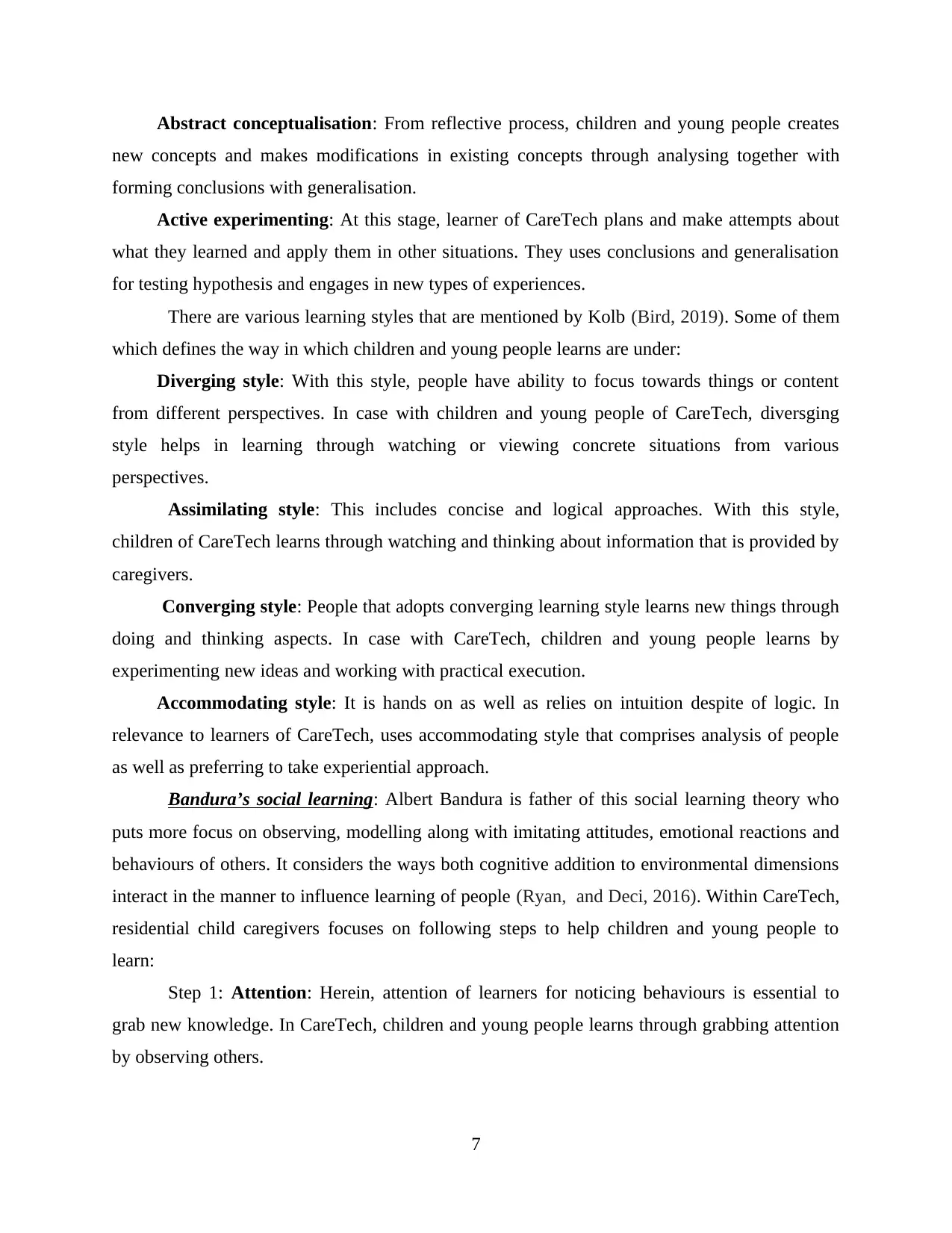
Abstract conceptualisation: From reflective process, children and young people creates
new concepts and makes modifications in existing concepts through analysing together with
forming conclusions with generalisation.
Active experimenting: At this stage, learner of CareTech plans and make attempts about
what they learned and apply them in other situations. They uses conclusions and generalisation
for testing hypothesis and engages in new types of experiences.
There are various learning styles that are mentioned by Kolb (Bird, 2019). Some of them
which defines the way in which children and young people learns are under:
Diverging style: With this style, people have ability to focus towards things or content
from different perspectives. In case with children and young people of CareTech, diversging
style helps in learning through watching or viewing concrete situations from various
perspectives.
Assimilating style: This includes concise and logical approaches. With this style,
children of CareTech learns through watching and thinking about information that is provided by
caregivers.
Converging style: People that adopts converging learning style learns new things through
doing and thinking aspects. In case with CareTech, children and young people learns by
experimenting new ideas and working with practical execution.
Accommodating style: It is hands on as well as relies on intuition despite of logic. In
relevance to learners of CareTech, uses accommodating style that comprises analysis of people
as well as preferring to take experiential approach.
Bandura’s social learning: Albert Bandura is father of this social learning theory who
puts more focus on observing, modelling along with imitating attitudes, emotional reactions and
behaviours of others. It considers the ways both cognitive addition to environmental dimensions
interact in the manner to influence learning of people (Ryan, and Deci, 2016). Within CareTech,
residential child caregivers focuses on following steps to help children and young people to
learn:
Step 1: Attention: Herein, attention of learners for noticing behaviours is essential to
grab new knowledge. In CareTech, children and young people learns through grabbing attention
by observing others.
7
new concepts and makes modifications in existing concepts through analysing together with
forming conclusions with generalisation.
Active experimenting: At this stage, learner of CareTech plans and make attempts about
what they learned and apply them in other situations. They uses conclusions and generalisation
for testing hypothesis and engages in new types of experiences.
There are various learning styles that are mentioned by Kolb (Bird, 2019). Some of them
which defines the way in which children and young people learns are under:
Diverging style: With this style, people have ability to focus towards things or content
from different perspectives. In case with children and young people of CareTech, diversging
style helps in learning through watching or viewing concrete situations from various
perspectives.
Assimilating style: This includes concise and logical approaches. With this style,
children of CareTech learns through watching and thinking about information that is provided by
caregivers.
Converging style: People that adopts converging learning style learns new things through
doing and thinking aspects. In case with CareTech, children and young people learns by
experimenting new ideas and working with practical execution.
Accommodating style: It is hands on as well as relies on intuition despite of logic. In
relevance to learners of CareTech, uses accommodating style that comprises analysis of people
as well as preferring to take experiential approach.
Bandura’s social learning: Albert Bandura is father of this social learning theory who
puts more focus on observing, modelling along with imitating attitudes, emotional reactions and
behaviours of others. It considers the ways both cognitive addition to environmental dimensions
interact in the manner to influence learning of people (Ryan, and Deci, 2016). Within CareTech,
residential child caregivers focuses on following steps to help children and young people to
learn:
Step 1: Attention: Herein, attention of learners for noticing behaviours is essential to
grab new knowledge. In CareTech, children and young people learns through grabbing attention
by observing others.
7
⊘ This is a preview!⊘
Do you want full access?
Subscribe today to unlock all pages.

Trusted by 1+ million students worldwide
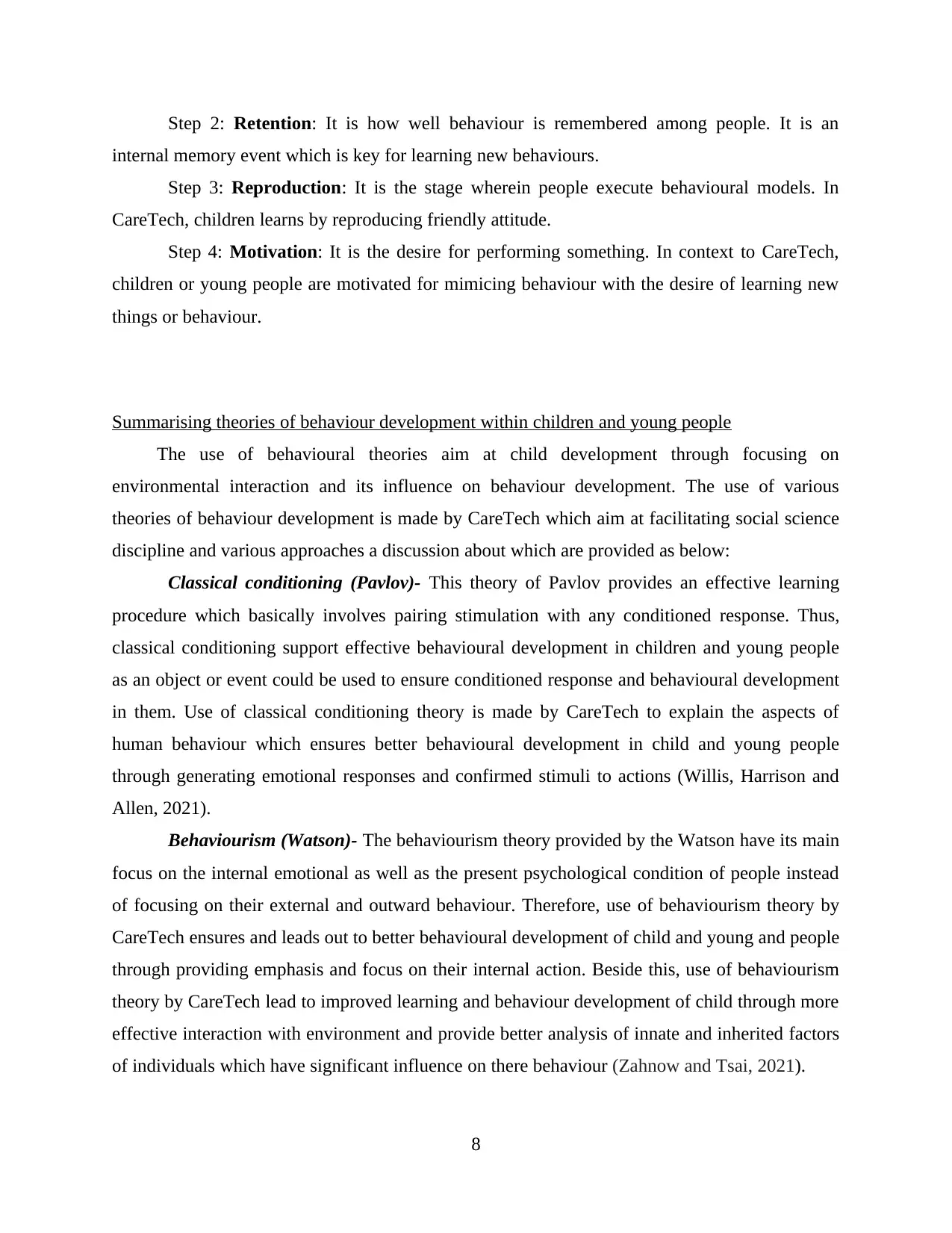
Step 2: Retention: It is how well behaviour is remembered among people. It is an
internal memory event which is key for learning new behaviours.
Step 3: Reproduction: It is the stage wherein people execute behavioural models. In
CareTech, children learns by reproducing friendly attitude.
Step 4: Motivation: It is the desire for performing something. In context to CareTech,
children or young people are motivated for mimicing behaviour with the desire of learning new
things or behaviour.
Summarising theories of behaviour development within children and young people
The use of behavioural theories aim at child development through focusing on
environmental interaction and its influence on behaviour development. The use of various
theories of behaviour development is made by CareTech which aim at facilitating social science
discipline and various approaches a discussion about which are provided as below:
Classical conditioning (Pavlov)- This theory of Pavlov provides an effective learning
procedure which basically involves pairing stimulation with any conditioned response. Thus,
classical conditioning support effective behavioural development in children and young people
as an object or event could be used to ensure conditioned response and behavioural development
in them. Use of classical conditioning theory is made by CareTech to explain the aspects of
human behaviour which ensures better behavioural development in child and young people
through generating emotional responses and confirmed stimuli to actions (Willis, Harrison and
Allen, 2021).
Behaviourism (Watson)- The behaviourism theory provided by the Watson have its main
focus on the internal emotional as well as the present psychological condition of people instead
of focusing on their external and outward behaviour. Therefore, use of behaviourism theory by
CareTech ensures and leads out to better behavioural development of child and young and people
through providing emphasis and focus on their internal action. Beside this, use of behaviourism
theory by CareTech lead to improved learning and behaviour development of child through more
effective interaction with environment and provide better analysis of innate and inherited factors
of individuals which have significant influence on there behaviour (Zahnow and Tsai, 2021).
8
internal memory event which is key for learning new behaviours.
Step 3: Reproduction: It is the stage wherein people execute behavioural models. In
CareTech, children learns by reproducing friendly attitude.
Step 4: Motivation: It is the desire for performing something. In context to CareTech,
children or young people are motivated for mimicing behaviour with the desire of learning new
things or behaviour.
Summarising theories of behaviour development within children and young people
The use of behavioural theories aim at child development through focusing on
environmental interaction and its influence on behaviour development. The use of various
theories of behaviour development is made by CareTech which aim at facilitating social science
discipline and various approaches a discussion about which are provided as below:
Classical conditioning (Pavlov)- This theory of Pavlov provides an effective learning
procedure which basically involves pairing stimulation with any conditioned response. Thus,
classical conditioning support effective behavioural development in children and young people
as an object or event could be used to ensure conditioned response and behavioural development
in them. Use of classical conditioning theory is made by CareTech to explain the aspects of
human behaviour which ensures better behavioural development in child and young people
through generating emotional responses and confirmed stimuli to actions (Willis, Harrison and
Allen, 2021).
Behaviourism (Watson)- The behaviourism theory provided by the Watson have its main
focus on the internal emotional as well as the present psychological condition of people instead
of focusing on their external and outward behaviour. Therefore, use of behaviourism theory by
CareTech ensures and leads out to better behavioural development of child and young and people
through providing emphasis and focus on their internal action. Beside this, use of behaviourism
theory by CareTech lead to improved learning and behaviour development of child through more
effective interaction with environment and provide better analysis of innate and inherited factors
of individuals which have significant influence on there behaviour (Zahnow and Tsai, 2021).
8
Paraphrase This Document
Need a fresh take? Get an instant paraphrase of this document with our AI Paraphraser
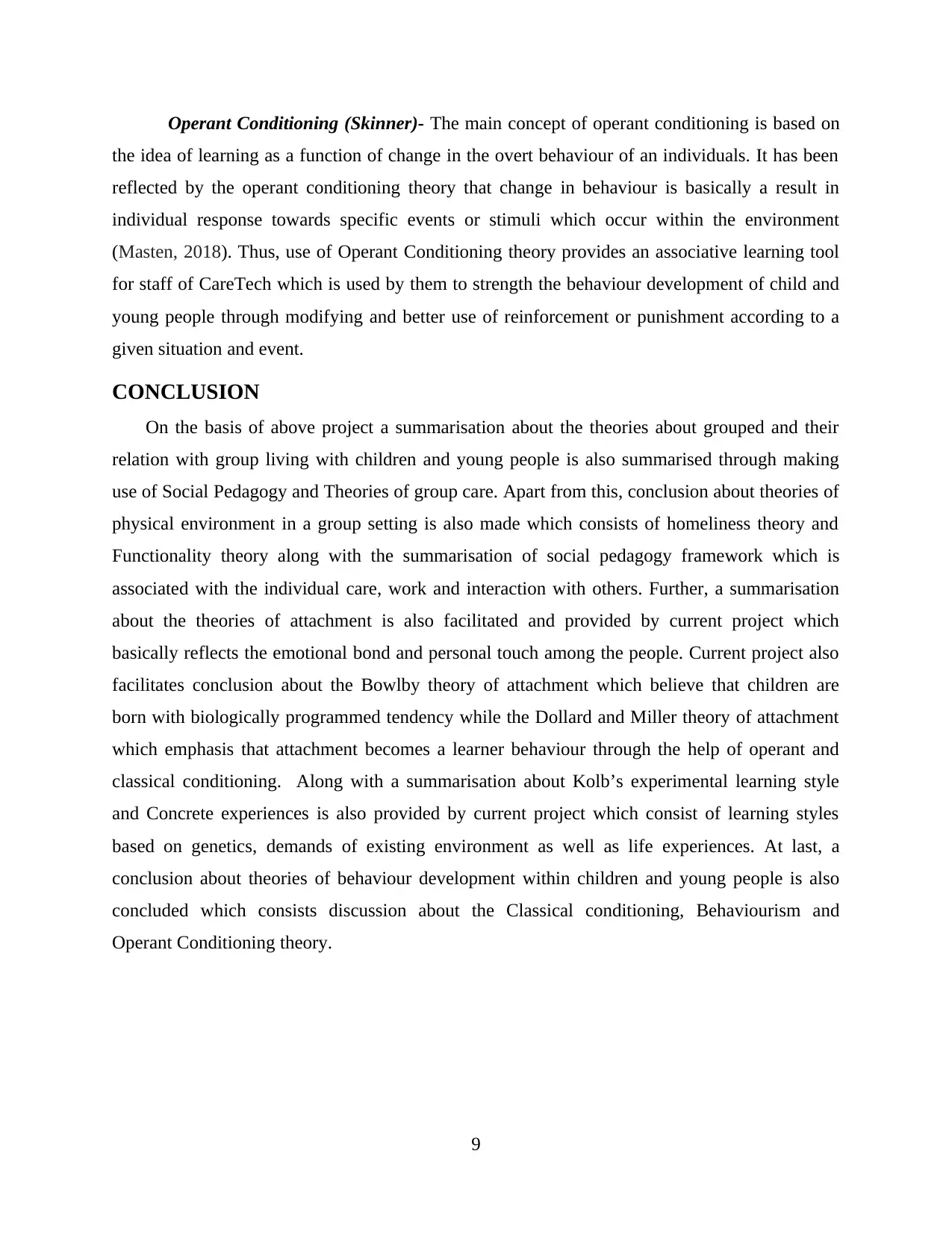
Operant Conditioning (Skinner)- The main concept of operant conditioning is based on
the idea of learning as a function of change in the overt behaviour of an individuals. It has been
reflected by the operant conditioning theory that change in behaviour is basically a result in
individual response towards specific events or stimuli which occur within the environment
(Masten, 2018). Thus, use of Operant Conditioning theory provides an associative learning tool
for staff of CareTech which is used by them to strength the behaviour development of child and
young people through modifying and better use of reinforcement or punishment according to a
given situation and event.
CONCLUSION
On the basis of above project a summarisation about the theories about grouped and their
relation with group living with children and young people is also summarised through making
use of Social Pedagogy and Theories of group care. Apart from this, conclusion about theories of
physical environment in a group setting is also made which consists of homeliness theory and
Functionality theory along with the summarisation of social pedagogy framework which is
associated with the individual care, work and interaction with others. Further, a summarisation
about the theories of attachment is also facilitated and provided by current project which
basically reflects the emotional bond and personal touch among the people. Current project also
facilitates conclusion about the Bowlby theory of attachment which believe that children are
born with biologically programmed tendency while the Dollard and Miller theory of attachment
which emphasis that attachment becomes a learner behaviour through the help of operant and
classical conditioning. Along with a summarisation about Kolb’s experimental learning style
and Concrete experiences is also provided by current project which consist of learning styles
based on genetics, demands of existing environment as well as life experiences. At last, a
conclusion about theories of behaviour development within children and young people is also
concluded which consists discussion about the Classical conditioning, Behaviourism and
Operant Conditioning theory.
9
the idea of learning as a function of change in the overt behaviour of an individuals. It has been
reflected by the operant conditioning theory that change in behaviour is basically a result in
individual response towards specific events or stimuli which occur within the environment
(Masten, 2018). Thus, use of Operant Conditioning theory provides an associative learning tool
for staff of CareTech which is used by them to strength the behaviour development of child and
young people through modifying and better use of reinforcement or punishment according to a
given situation and event.
CONCLUSION
On the basis of above project a summarisation about the theories about grouped and their
relation with group living with children and young people is also summarised through making
use of Social Pedagogy and Theories of group care. Apart from this, conclusion about theories of
physical environment in a group setting is also made which consists of homeliness theory and
Functionality theory along with the summarisation of social pedagogy framework which is
associated with the individual care, work and interaction with others. Further, a summarisation
about the theories of attachment is also facilitated and provided by current project which
basically reflects the emotional bond and personal touch among the people. Current project also
facilitates conclusion about the Bowlby theory of attachment which believe that children are
born with biologically programmed tendency while the Dollard and Miller theory of attachment
which emphasis that attachment becomes a learner behaviour through the help of operant and
classical conditioning. Along with a summarisation about Kolb’s experimental learning style
and Concrete experiences is also provided by current project which consist of learning styles
based on genetics, demands of existing environment as well as life experiences. At last, a
conclusion about theories of behaviour development within children and young people is also
concluded which consists discussion about the Classical conditioning, Behaviourism and
Operant Conditioning theory.
9
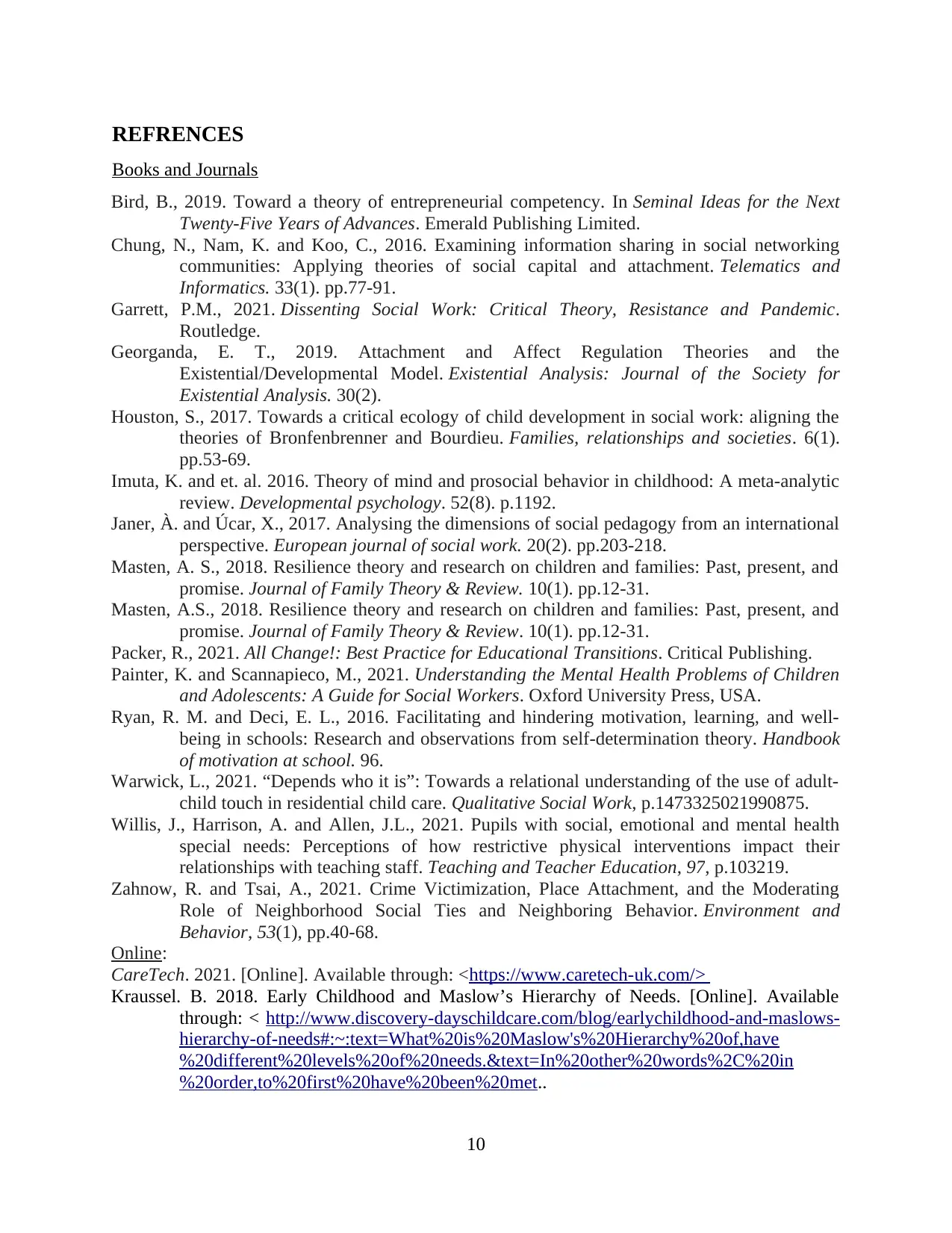
REFRENCES
Books and Journals
Bird, B., 2019. Toward a theory of entrepreneurial competency. In Seminal Ideas for the Next
Twenty-Five Years of Advances. Emerald Publishing Limited.
Chung, N., Nam, K. and Koo, C., 2016. Examining information sharing in social networking
communities: Applying theories of social capital and attachment. Telematics and
Informatics. 33(1). pp.77-91.
Garrett, P.M., 2021. Dissenting Social Work: Critical Theory, Resistance and Pandemic.
Routledge.
Georganda, E. T., 2019. Attachment and Affect Regulation Theories and the
Existential/Developmental Model. Existential Analysis: Journal of the Society for
Existential Analysis. 30(2).
Houston, S., 2017. Towards a critical ecology of child development in social work: aligning the
theories of Bronfenbrenner and Bourdieu. Families, relationships and societies. 6(1).
pp.53-69.
Imuta, K. and et. al. 2016. Theory of mind and prosocial behavior in childhood: A meta-analytic
review. Developmental psychology. 52(8). p.1192.
Janer, À. and Úcar, X., 2017. Analysing the dimensions of social pedagogy from an international
perspective. European journal of social work. 20(2). pp.203-218.
Masten, A. S., 2018. Resilience theory and research on children and families: Past, present, and
promise. Journal of Family Theory & Review. 10(1). pp.12-31.
Masten, A.S., 2018. Resilience theory and research on children and families: Past, present, and
promise. Journal of Family Theory & Review. 10(1). pp.12-31.
Packer, R., 2021. All Change!: Best Practice for Educational Transitions. Critical Publishing.
Painter, K. and Scannapieco, M., 2021. Understanding the Mental Health Problems of Children
and Adolescents: A Guide for Social Workers. Oxford University Press, USA.
Ryan, R. M. and Deci, E. L., 2016. Facilitating and hindering motivation, learning, and well-
being in schools: Research and observations from self-determination theory. Handbook
of motivation at school. 96.
Warwick, L., 2021. “Depends who it is”: Towards a relational understanding of the use of adult-
child touch in residential child care. Qualitative Social Work, p.1473325021990875.
Willis, J., Harrison, A. and Allen, J.L., 2021. Pupils with social, emotional and mental health
special needs: Perceptions of how restrictive physical interventions impact their
relationships with teaching staff. Teaching and Teacher Education, 97, p.103219.
Zahnow, R. and Tsai, A., 2021. Crime Victimization, Place Attachment, and the Moderating
Role of Neighborhood Social Ties and Neighboring Behavior. Environment and
Behavior, 53(1), pp.40-68.
Online:
CareTech. 2021. [Online]. Available through: <https://www.caretech-uk.com/>
Kraussel. B. 2018. Early Childhood and Maslow’s Hierarchy of Needs. [Online]. Available
through: < http://www.discovery-dayschildcare.com/blog/earlychildhood-and-maslows-
hierarchy-of-needs#:~:text=What%20is%20Maslow's%20Hierarchy%20of,have
%20different%20levels%20of%20needs.&text=In%20other%20words%2C%20in
%20order,to%20first%20have%20been%20met..
10
Books and Journals
Bird, B., 2019. Toward a theory of entrepreneurial competency. In Seminal Ideas for the Next
Twenty-Five Years of Advances. Emerald Publishing Limited.
Chung, N., Nam, K. and Koo, C., 2016. Examining information sharing in social networking
communities: Applying theories of social capital and attachment. Telematics and
Informatics. 33(1). pp.77-91.
Garrett, P.M., 2021. Dissenting Social Work: Critical Theory, Resistance and Pandemic.
Routledge.
Georganda, E. T., 2019. Attachment and Affect Regulation Theories and the
Existential/Developmental Model. Existential Analysis: Journal of the Society for
Existential Analysis. 30(2).
Houston, S., 2017. Towards a critical ecology of child development in social work: aligning the
theories of Bronfenbrenner and Bourdieu. Families, relationships and societies. 6(1).
pp.53-69.
Imuta, K. and et. al. 2016. Theory of mind and prosocial behavior in childhood: A meta-analytic
review. Developmental psychology. 52(8). p.1192.
Janer, À. and Úcar, X., 2017. Analysing the dimensions of social pedagogy from an international
perspective. European journal of social work. 20(2). pp.203-218.
Masten, A. S., 2018. Resilience theory and research on children and families: Past, present, and
promise. Journal of Family Theory & Review. 10(1). pp.12-31.
Masten, A.S., 2018. Resilience theory and research on children and families: Past, present, and
promise. Journal of Family Theory & Review. 10(1). pp.12-31.
Packer, R., 2021. All Change!: Best Practice for Educational Transitions. Critical Publishing.
Painter, K. and Scannapieco, M., 2021. Understanding the Mental Health Problems of Children
and Adolescents: A Guide for Social Workers. Oxford University Press, USA.
Ryan, R. M. and Deci, E. L., 2016. Facilitating and hindering motivation, learning, and well-
being in schools: Research and observations from self-determination theory. Handbook
of motivation at school. 96.
Warwick, L., 2021. “Depends who it is”: Towards a relational understanding of the use of adult-
child touch in residential child care. Qualitative Social Work, p.1473325021990875.
Willis, J., Harrison, A. and Allen, J.L., 2021. Pupils with social, emotional and mental health
special needs: Perceptions of how restrictive physical interventions impact their
relationships with teaching staff. Teaching and Teacher Education, 97, p.103219.
Zahnow, R. and Tsai, A., 2021. Crime Victimization, Place Attachment, and the Moderating
Role of Neighborhood Social Ties and Neighboring Behavior. Environment and
Behavior, 53(1), pp.40-68.
Online:
CareTech. 2021. [Online]. Available through: <https://www.caretech-uk.com/>
Kraussel. B. 2018. Early Childhood and Maslow’s Hierarchy of Needs. [Online]. Available
through: < http://www.discovery-dayschildcare.com/blog/earlychildhood-and-maslows-
hierarchy-of-needs#:~:text=What%20is%20Maslow's%20Hierarchy%20of,have
%20different%20levels%20of%20needs.&text=In%20other%20words%2C%20in
%20order,to%20first%20have%20been%20met..
10
⊘ This is a preview!⊘
Do you want full access?
Subscribe today to unlock all pages.

Trusted by 1+ million students worldwide
1 out of 13
Related Documents
Your All-in-One AI-Powered Toolkit for Academic Success.
+13062052269
info@desklib.com
Available 24*7 on WhatsApp / Email
![[object Object]](/_next/static/media/star-bottom.7253800d.svg)
Unlock your academic potential
Copyright © 2020–2025 A2Z Services. All Rights Reserved. Developed and managed by ZUCOL.





